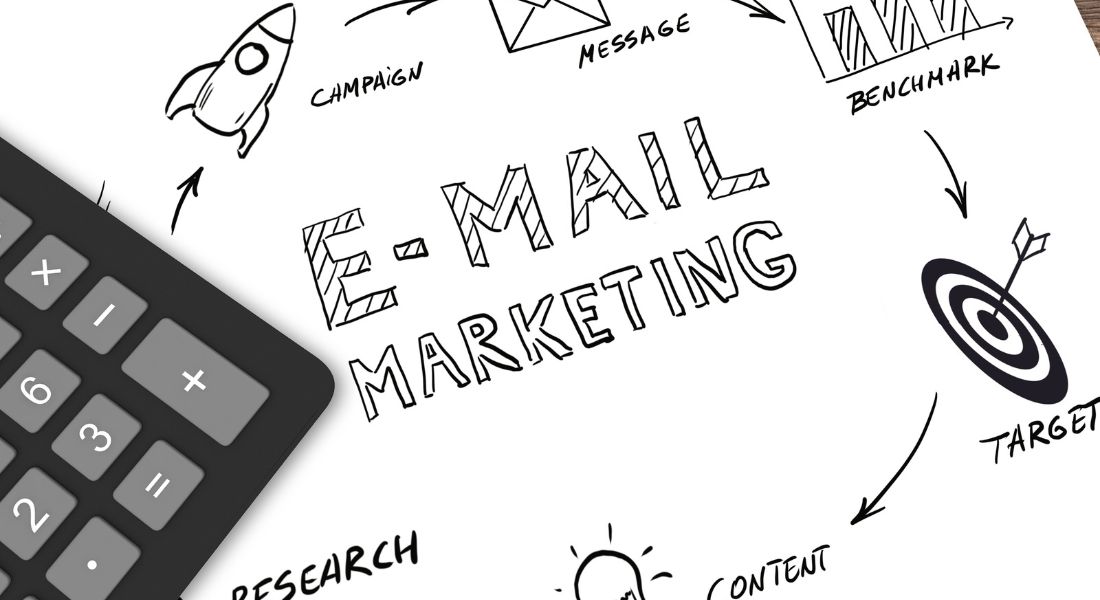Imagine this: A perfectly crafted message lands in the inboxes of your target audience, enticing them to open it and dive into the delightful world of your brand. That’s not just any email; it’s an expertly designed masterpiece of email marketing. In today’s fast-paced digital era, effectively connecting with your customers hinges on mastering this invaluable tool. Enter our Ultimate Guide to Email Marketing for Business: Tips, Strategies, and Best Practises, where we reveal the magic behind the curtain that transforms regular emails into powerful tools for success. Are you ready to craft your own masterpieces? Stay tuned!
Our Ultimate Guide to Email Marketing for Business covers everything from understanding the different types of email marketing campaigns, building an email list, drafting effective newsletters and promotional emails, segmenting your audience, analysing campaign performance metrics, A/B testing, and best practises for avoiding common pitfalls. It is designed to help small and medium-sized businesses maximise their email marketing efforts by following industry-leading strategies that drive engagement and conversion rates.
Post Contents
ToggleUnderstanding Email Marketing for Businesses
Email marketing is a powerful and cost-effective way to reach out to your target audience and stay top of mind with your customers. It allows businesses to communicate effectively with their subscribers, maintain relationships with them, and ultimately drive sales growth.
To fully grasp the concept of email marketing, it is important to recognise that it involves more than just sending out promotional content on a regular basis. Done correctly, email marketing should add value to your subscribers’ lives by providing valuable content, exclusive discounts, and information about upcoming events or product launches.
Additionally, it’s crucial to understand that email marketing involves building trust between your business and your subscribers. Building a relationship requires consistency in communication. Therefore, creating an effective email campaign should include creating quality content on a regular basis that reflects the interests of your subscribers.
For example, if you are a coffee roaster company with various blends of coffee, sending weekly emails with discount coupons and recipes featuring different blends can show subscribers that there is a vast variety of options available. Additionally, including interviews with local farmers who sustainably source coffee beans can lend credibility to the brand as being ethically responsible.
Another crucial aspect of understanding email marketing for businesses is recognising the importance of maintaining high standards in regards to data privacy and security. It’s vital to respect subscriber preferences such as frequency of emails they receive from you or what types of information they are interested in receiving.
All these elements will make email communications from businesses more welcome in people’s inboxes which leads to higher open rates and fewer opt-outs.
It’s important not only for people to be interested but also engaged enough for them to interact with the content in the emails as well. In fact studies show that interactive email campaigns drive up engagement rates by over 300%.
To get the most out of an email campaign strategy it makes sense for businesses to focus their efforts on growing and segmenting their subscribers list.

Building and Segmenting Your Subscribers List
The foundation of any successful email campaign is compiling a robust subscribers’ list. It is important to recognise that not every email address or lead is created equal. While achieving high numbers of leads may be the primary objective, it’s more valuable for businesses to focus on quality leads over quantity.
To achieve this, businesses need to focus on attracting subscribers who are genuinely interested in the product, service or content offered. There are several ways to go about this, but some common methods include having prominent opt-in forms visible across the website, promoting emails at industry events, offering exclusive subscriptions such as monthly newsletters with interesting industry news or providing manuals and guides, to name a few.
Some businesses may even offer exciting opportunities like early access to sales during a special promotion or the chance to review an upcoming product line first. However, using these methods too aggressively can do more harm than good by damaging brand reputation and annoying potential subscribers. Therefore finding harmony between being active but not invasive remains very important in building quality subscribers’ lists.
Once businesses have a pool of subscribers they must effectively break down their subscribers into specific segments based either on demographics or interests/habits of that particular segment of customers (e.g., based on purchase history). Doing so ensures that information relevant to specific groups is sent opposed to sending uniform emails which come across as impersonalization which can lead to increased dropouts.
To put it into perspective, imagine you owned an online store for athletic gear. Being able to segment your subscribers by “young runners” and “baby boomers walkers” would enable businesses to develop marketing campaigns specifically speaking directly towards each group of people in different ways rather than sending one blast email which speaks about both running shoes and walking shoes making them lose interest.
Maintaining a clean list also plays a vital role in maintaining high engagement rates and successful deliverability. It’s important for businesses to regularly clean their subscribers’ list by removing inactive subscribers or addresses that provide incorrect information.
Content Strategy for Your Emails
When it comes to email marketing, content is king. Crafting a well-designed and attention-grabbing email is crucial, but it’s the content that will ultimately determine whether or not your subscribers engage with your message.
Your content strategy should reflect your brand voice and mission, while also catering to your target audience. This means considering the type of content that will be most appealing and useful to them, such as educational resources, promotional offers, or industry news updates.
In addition, your content should be concise and scannable. Avoid long blocks of text and instead use bullet points and subheadings to break up the information and make it easier to digest.
For example, if you’re an online clothing retailer targeting young adults, your email content might feature trendy outfit ideas, exclusive coupon codes, and links to blog posts about fashion tips. On the other hand, if you’re a B2B software company targeting busy professionals, your email content might focus on case studies demonstrating how your product can solve common productivity challenges.
Ultimately, the key is to provide value to your subscribers while keeping their attention through engaging and relevant content.
One way to verify that your email content is hitting the mark is by tracking key metrics such as open rates and click-through rates. If you see large drop-offs in these areas over time, it may be an indicator that your content needs improvement.
Of course, there are many factors beyond simply the quality of the content involved in boosting engagement with emails. For example, the timing of when you send emails could play a role in determining how receptive subscribers are likely to be when they receive them. Nevertheless, strong email copywriting remains a vital ingredient in any successful campaign.
Maximising Email Campaign Impact
Once you have crafted compelling email content that resonates with your subscribers, it’s time to think about how to ensure that as many of them as possible actually see it.
That’s where maximising the impact of your email campaign comes into play. There are several strategies and best practices that businesses can use here, including personalization, A/B testing, and integration of email marketing efforts with broader business strategy.
Personalization is a particularly potent tool for boosting the impact of email campaigns. Research has shown that personalised emails can boost open rates by almost 20% and click-through rates by more than 2%, compared to generic ones.
One effective way to tailor your email content to individual subscribers is by segmenting your list according to demographic and behavioural criteria. This could involve grouping subscribers based on things like their purchase history or website behaviour; this in turn makes it easier to deliver relevant messages to each group that they are more likely to be interested in.
For example, imagine you’re a wedding photographer who offers both engagement shoots and full-day wedding photo packages. By creating separate email campaigns targeted at couples looking for one type of service or the other depending on their behaviour on your website, you can demonstrate the relevance of your message while also avoiding being perceived as spammy.
In some ways, crafting an effective email campaign is like sending out a fleet of boats onto a vast ocean: you want them all to reach their intended destination (paying customers), but some will inevitably get lost or off course along the way (uninterested recipients). By focusing on personalization and other strategies, however, you can increase the likelihood that more boats will ultimately make it back home – this in turn boosts your chances for success.

Best Practises for Personalization
In today’s fast-paced world, the majority of businesses use email as a primary marketing tool. However, to stand out in an overcrowded inbox, personalization is the key. Personalised emails not only help in building customer loyalty but also improve your ROI and revenue. According to research by Statista 2021, personalised emails have an 18.8% higher open rate and a 2.6% higher click-through rate than non-personalised ones. So, if you’re not personalising your emails yet, it’s high time to start.
Incorporating subscriber data like their name, location, and purchase history into your email campaigns can make a big difference in engagement levels. Additionally, sending personalised offers based on customer interests can improve conversion rates substantially.
However, personalization goes beyond just using a subscriber’s name in the introduction or greeting. To truly personalise emails and make them relevant to subscribers’ needs, you must segment your audience.
Mailchimp found that segmented email campaigns have a whopping 14.31% higher open rate and a 100.95% higher click-through rate than non-segmented campaigns. By dividing your subscribers into targeted groups based on factors like demographics, preferences, purchase history, or engagement behaviour, you can send more targeted content that resonates with their interests.
For instance, a sporting goods store can segment their subscribers into groups based on their preferred sport or fitness activity and send customised promotions accordingly.
Another way to personalise your email campaigns is by including dynamic content – different content items that adjust depending on each subscriber’s information such as preferences or behaviour.
A good analogy of this technique is Netflix’s recommendation engine which analyses users’ viewing history and suggests relevant TV shows or movies based on their previously watched content.
Finally, consider personalising all touchpoints within your email campaign, including the subject line. A study by Campaign Monitor 2019 found that using personalised subject lines can boost open rates by up to 26%.
- Personalization is the key to standing out in an overcrowded inbox. Incorporating subscriber data and segmenting your audience can substantially improve engagement levels and increase conversion rates. Including dynamic content and personalising all touchpoints in your email campaign, including the subject line, can further enhance the effectiveness of personalised emails. If you’re not personalising your emails yet, it’s high time to start for better ROI and revenue.
A/B Testing for Optimisation
A/B testing (or split testing) is a technique used to identify which version of an email or landing page is more effective in achieving business goals. By presenting different variations to a sample audience and measuring responses, you can optimise your campaigns and improve their performance.
For example, you can test different subject lines or call-to-actions (CTAs) to see which one drives more clicks or conversions.
To conduct an A/B test, start by selecting a single variable you’d like to examine and create at least two versions of that element. Then, randomly assign each group of subscribers to receive one of the versions – half will get Version A while the other half receives Version B.
After running the test for a set period, analyse the results to see which version performed better – did it generate more opens, clicks, leads, or revenue? Use the insights gathered from the test to improve future email campaigns.
It’s important to note that only test one variable at a time to have clear indications on what factors were responsible for any differences in response rates.
While A/B testing may seem time-consuming initially, it is an essential exercise for businesses looking to optimise their campaigns. Some argue that small businesses may not need A/B testing since they have fewer subscribers; however, this is precisely why it’s crucial – every subscriber is valuable and can impact results significantly.
For instance, if you’re an eCommerce store selling handmade jewellery online and notice a higher response rate from emails with free shipping offers versus one with $10 off coupon codes, you may want to rethink how you structure your promotions going forward.
The key is always to test, analyse and refine. By continually optimising your emails based on reliable data and insights gained from A/B testing, you can develop more effective email campaigns that resonate with your target audience.

Integrating Email Marketing into Your Business Strategy
Email marketing is a tool that can be integrated into your overall business strategy to increase sales and customer engagement. Using email as a way to effectively communicate with your subscribers can help build relationships, brand loyalty, and trust in your company.
For example, consider an online clothing store. Email marketing would allow the store to send specific promotions, such as discounts or limited-time offers, only to subscribers who have shown an interest in their products. By creating targeted emails focused on the subscribers’ interests, the store can increase click-through rates while also driving sales.
Some may worry that incorporating email marketing could be intrusive and lead to unsubscribes from customers feeling they receive too many emails. However, this concern can be alleviated by providing valuable information and tailored content rather than just focusing on promotions all the time. It’s important to remember that subscribers want to see value in what they are receiving from your business.
According to a survey by Hubspot, consumers prefer email marketing because it provides them with highly relevant content. By creating email campaigns that are tailored towards certain segments of your list, you can ensure the content resonates with them and increases engagement. This type of personalization helps customers feel valued and taken care of.
Think of email marketing like a virtual handshake – it’s important not only for building relationships but also for maintaining them. By consistently sending personalised emails containing useful information and interesting insights related to your industry, you will strengthen the connection between your company and its subscribers.
Some businesses may not realise the importance of integrating email marketing into their overall strategy or may think it’s too much effort for little return. However, statistics show that ignoring email marketing altogether could lead to missed opportunities and revenue generation.
In fact, according to a study by DMA, for every $1 spent on email marketing campaigns, the average return on investment (ROI) is $42. This highlights that email marketing continues to be a cost-effective and value-driven component of any business strategy.
Email marketing has the potential to be an incredibly effective tool for businesses to engage with customers and drive revenue. By integrating email marketing into your overall business strategy with a focus on personalization, segmentation, and providing valuable content, your company can increase customer engagement and sales while strengthening relationships with your subscriber base.





